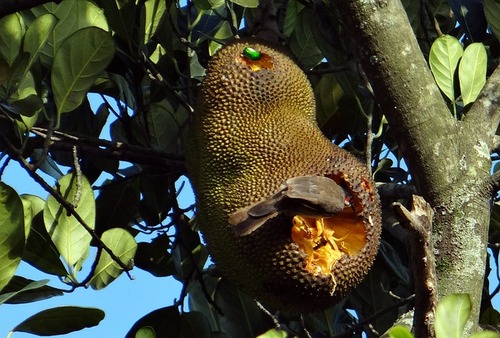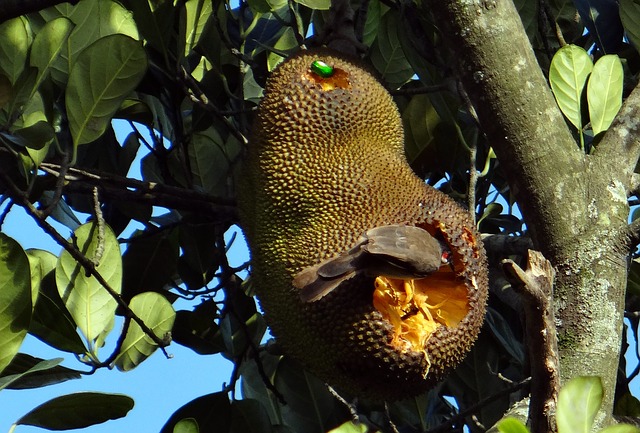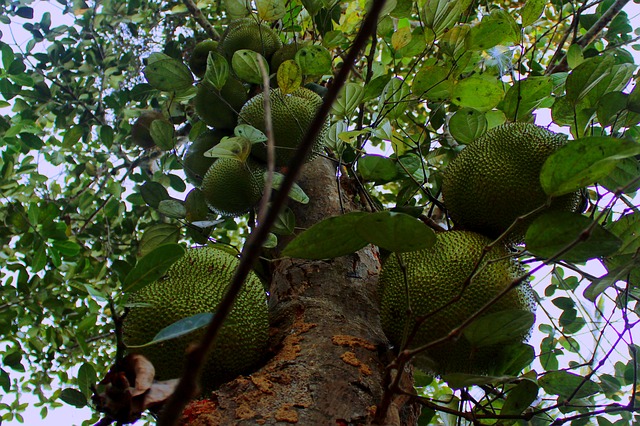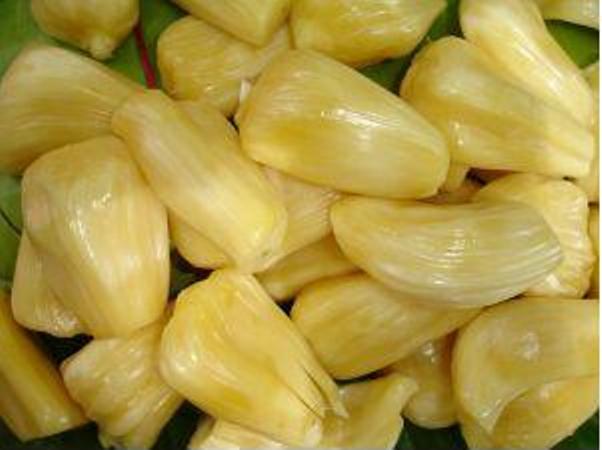

Geographic Origins and Regions Grown

The jackfruit is not on the top of some people’s list of fruits to try. It may very well be at the bottom. Its origin is somewhere in southwestern India, Bangladesh, Philippines, or Sri Lanka. Any place outside of these regions may be regretfully due to human intervention. It grows well in tropical lowlands so if you reside in this type of area and jackfruit is nearby you might want to relocate.
An early description of the jackfruit originates from the memoirs of the Mughal Emperor Babar who lived in the 16th century, who did not seem to be too much enamored by it. He describes it as being “unbelievably ugly and bad tasting” and goes on further with colorful uncomplimentary remarks.
This fruit is quite a bit larger than its average cousins, seldom less than about 25 cm in diameter. Even when a relatively smaller fruit is found, it is not uncommon to be located next to larger neighbors that can reach 36 kg in weight and grow up to 90 cm long and 50 cm in diameter, making it the largest fruit in the world that is tree borne.

Something of an acquired taste, the jackfruit is, simply put, nearly too sweet. Very popular in certain parts of the world, this unopened ripe fruit can have a smell that is quite unpleasant, like onions beginning to rot. Most people prefer to eat jackfruit in the most acceptable, full-grown, and unripe stage.
At this stage it does not have an offensive odor and pass in quality and taste the green and cooked breadfruit as well as the plantain. To prepare the fruit at this stage, simply cut it into large pieces for cooking. However, remember the sap in your preparations. Rub your hands and knife with a generous helping of oil before preparing this fruit.
In lightly salted water, boiled until tender, the jackfruit serves as a rather delicious snack when the substance of the fruit can be sliced from the middle of the fruit and served as a vegetable with the seeds intact. The sap or “latex” that clings to the pot while being boiled can be removed through rubbing vigorously using oil.
The unripe flesh of the fruit has been canned with curry as well as other substances as an experiment, creating some interesting results. Many things work with curry so it might be worth a try. It is not uncommon to see some dried variations of the jackfruit, stored in tins for up to a year. The individual sampled slices of these dried fruits are unripe and are usually sold in the native markets of Thailand.

The jackfruit is definitely a fruit that takes you back to nature. If ripened, the seeds and bulbs should be extracted outdoors to avoid the odor that will permeate your house. It is similar to preparing horseradish. I’m sure some of you know what I’m talking about. The bulbs can then be consumed either raw or cooked.
These seeds can appeal to a large variety of tastes and are often times processed through a syrup, much like chestnuts – either boiled, roasted, or preserved. These unique seeds have also been canned in brine with some success, as well as in curry, and like baked beans in tomato sauce. Often included in curried dishes, they are sometimes roasted, with the dried seeds ground to into flour that blends well with wheat flour for baking creating a different mix of texture and taste.
Yes we all may have a recipe or two that makes us wonder why we are cooking this. Maybe because of a distasteful preparation method or scents that could turn the strongest of stomachs. The jackfruit rates high on the malodorous scale, but it is worth it in the end.
Jackfruit is an excellent source of potassium and vitamin C. Jackfruit contains 38% carbohydrates, 6.6% proteins and 0.4 g fat, vitamins A, C and B, and calcium, zinc, and phosphorous. Below are the jackfruit nutrition facts in table form, more details here at usda.gov :

The jackfruit root is a remedy for skin diseases and asthma. An extract of the root is taken to cure fever and diarrhea (1) as well. Jackfruit provides a good supply of proteins, carbohydrates, and vitamins. Its health benefits are wide-ranging from anti-cancer (2), (3) and antihypertensive to anti-aging (4) and anti-ulcer.
1. Goncalves, J. L., Lopes, R. C., Oliveira, D. B., Costa, S. S., Miranda, M. M., Romanos, M. T., et al. (2005). In vitro anti-rotavirus activity of some medicinal plants used in Brazil against diarrhea. Journal of Ethnopharmacology, 99(3), 403-407.
2. Kabir, S. (1998). Jacalin: A jackfruit (Artocarpus heterophyllus) seed-derived lectin of versatile applications in immunobiological research. Journal of Immunological Methods, 212(2), 193-211.
3. Remani, P., Bhattathiri, V. N., Bindu, L., Chandralekha, B., Vijayakumar, T., & Nair, M. K. (1997). Correlation of lectin binding with lymph node metastasis in oral cancers. Oral Oncology, 33(1), 19-22.
4. Soubir, T. (2007). Antioxidant activities of some local bangladeshi fruits (Artocarpus heterophyllus, Annona squamosa, Terminalia bellirica, Syzygium samarangense, Averrhoa carambola and Olea europa). Sheng Wu Gong Cheng Xue Bao, 23(2), 257-261.
